Many people walking past the wall of St Bartholomew’s Hospital on West Smithfield, close to the memorial to William Wallace, stop to look at a series of craters and marks on the wall that look as though they were caused by an explosion of some sort. These scars are from a devastating V2 rocket attack on the area during the Second World War, but this wasn’t the first aerial attack to bring death and destruction to this part of London. Bartholomew Close, not far from the scarred walls, was hit during one of the very first air raids on London, a terrifying Zeppelin raid in 1915.
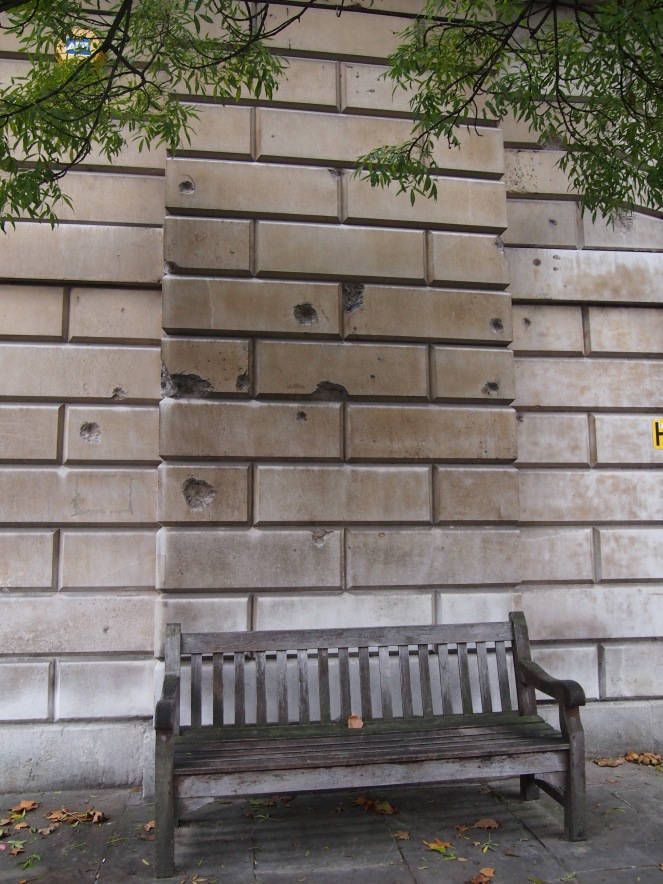
The huge bomb, thought to contain around 300kg of explosives, caused an enormous amount of destruction in Bartholomew Close, where two people lost their lives. This image shows the extent of the destruction in Bartholomew Close, with buildings being completely gutted. A crater eight feet deep was left in the street. The picture below shows a type of bomb that was being dropped by the German airships.

Not far from Bartholomew Close lies a reminder of those early, terrifying air raids on London. On Farringdon Road, a building was completely destroyed in a Zeppelin raid on 8th September 1915 and when it was rebuilt, a lasting memorial to the attack was added to the new building, which was named Zeppelin Building in memory of the raid that had destroyed its predecessor.
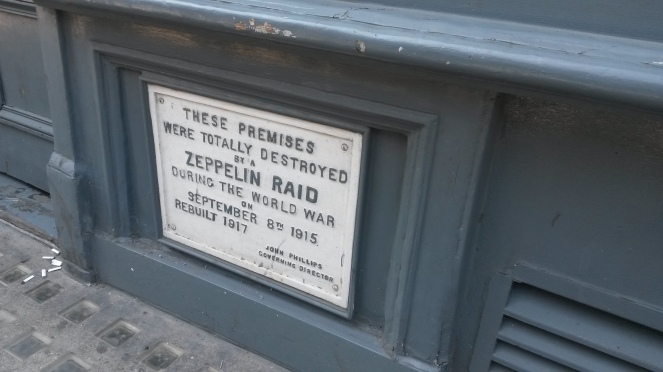
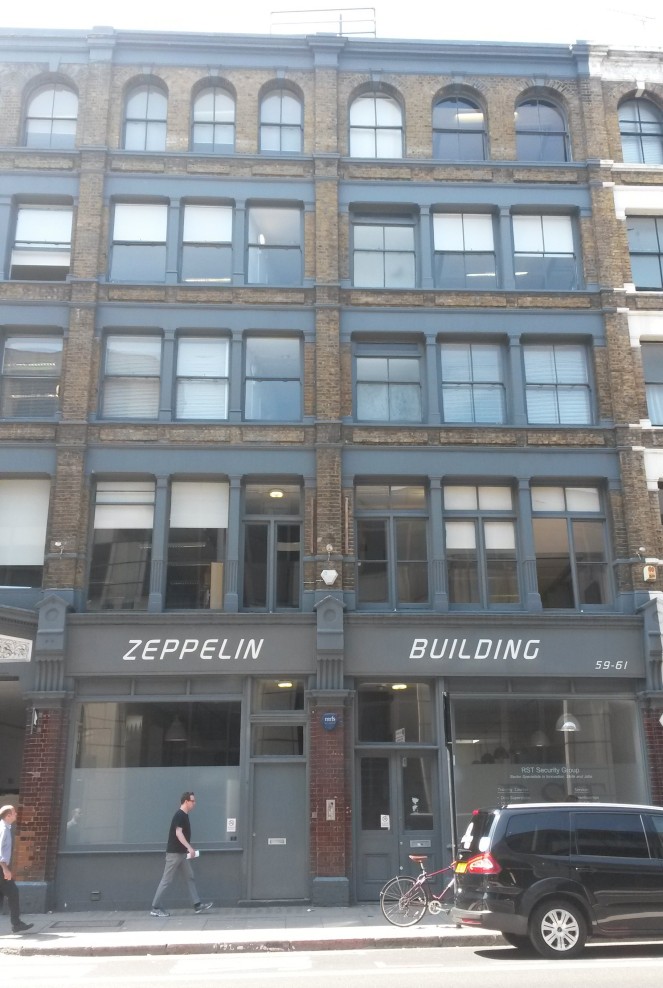
The first Zeppelin raids on London had been in May 1915 – shocking attacks that rocked the city physically and psychologically. Attacks on Stoke Newington and Stepney killed seven people, including a number of children. The indiscriminate nature of the aerial bombings and the civilian casualties they caused earned the airships the chilling nickname of “baby killers.”

It is unsurprising that the fear generated by the air raids over London and other parts of England was utilised by propagandists looking to encourage more men to volunteer for the British armed forces.
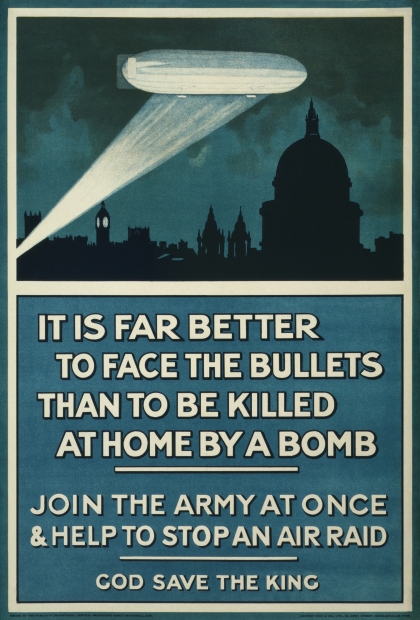
Though the first raids came as a shock and a surprise, the fear of air raids had been building in London since the outbreak of war. Within weeks of the outbreak of war, restrictions on what lights could be lit at night in London were put into place. Zeppelins had already raided coastal towns such as Great Yarmouth, Sheringham and King’s Lynn, with the first raid on the east coast happening in January 1915. London’s air defences were at first almost completely ineffective and the airships were able to carry out their bombing raids without being damaged. This impotence in the face of attack must have greatly added to Londoners’ fears in this period. The Zeppelin raids all happened during the night, the cover of darkness helping to conceal the monstrous airships.
Heralded by the deep throb of its powerful engines, the dark, menacing Zeppelin – a blacker shape, barely visible against the night sky – instilled terror in London’s population. (Neil Hanson – First Blitz, p.43)
Air defences gradually improved and as they did, the airships became more vulnerable. By the middle of 1916, hundreds of searchlights and anti-aircraft guns had been installed across Britain. Large, slow-moving airships made easy targets for the anti-aircraft guns compared to smaller, more agile aeroplanes that could more easily duck and dive to avoid gunfire. The vulnerability of the huge airships, as well as their slowness and difficulty flying in high winds, meant that the later air raids on London and other parts of Britain were carried out by aeroplanes, particularly the feared Gotha bombers. A Gotha raid was responsible for the well-known damage to one of the sphinxes that flank Cleopatra’s Needle on the Victoria Embankment.
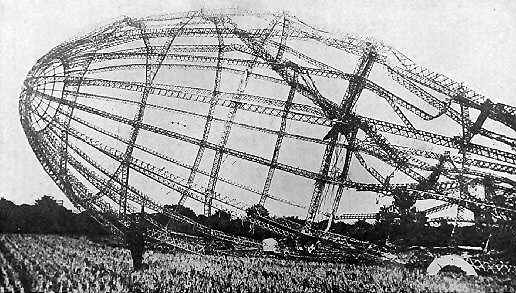
The air raids affected places all over the city, particularly in South East London. Areas such as Bermondsey, Deptford, Eltham and Plumstead suffered bomb damage and fatalities, as did Liverpool St station, the West End and East Croydon. In October 1915, three Zeppelins attacked London on the same night, with dozens of people being killed, thirty-eight in Central London alone.
During the fiercest battles of the First World War, Londoners became accustomed to hearing the distant booms of the guns over the English Channel in France. But the aerial bombardment from German airships and aeroplanes brought the destruction of the war to people’s doorsteps. Homes, railway stations and businesses were damaged or destroyed, fires broke out and windows were smashed. Despite the terror of the raids, crowds gathered around the ruins once the threat from the Zeppelins had passed.

The Zeppelins were the largest and the most well known of the German aerial threats during the war, but they were not the only German airships to menace the skies of Britain during the First World War, and the British forces also had a number of airships at their disposal. Posters were issued to help the public identify friendly and enemy airships and aeroplanes, in an attempt to prevent unnecessary panic if British airships were sighted.
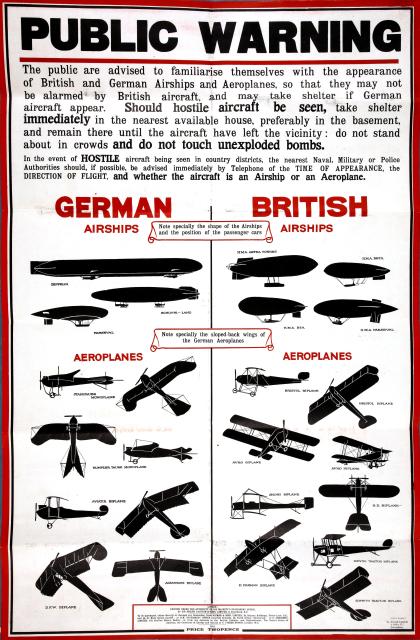
Zeppelins were invented by Count Ferdinand von Zeppelin, whose interest in lighter-than-air transport had been piqued by his visits to balloon stations in America during the Civil War. He began to design airships in the 1870s, and after retiring from the armed forces in 1891 devoted all of his time to the development of airships. His pioneering work in the field of aeronautics means that his name has become synonymous with all airships, not just those of his own design.

Zeppelins reappeared in London’s skies in a more peaceful context a decade or so after the end of the First World War. By this time, huge airships were no longer instruments of terror in war but sumptuous cruise liners of the sky, carrying people in comfort over long distances. The Graf Zeppelin, pictured below, was one of these luxurious airships.
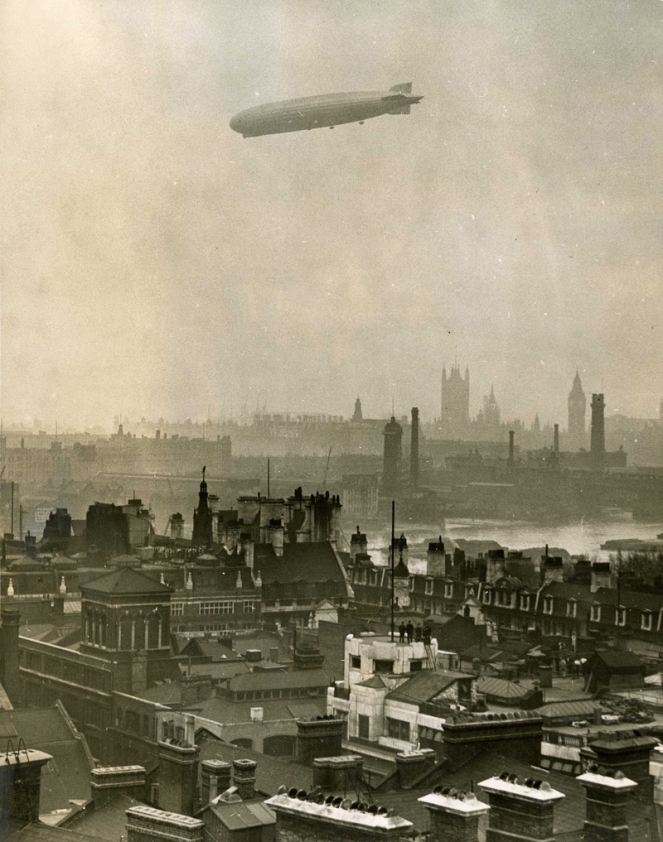
This is not to say that the Zeppelin had lost all of its associations with the First World War. When the Graf Zeppelin flew over Wembley during the 1930 FA Cup final, it was greeted by a chorus of boos from the crowd below. Many years had passed since the terrifying air raids over London, but Londoners had not forgotten them.
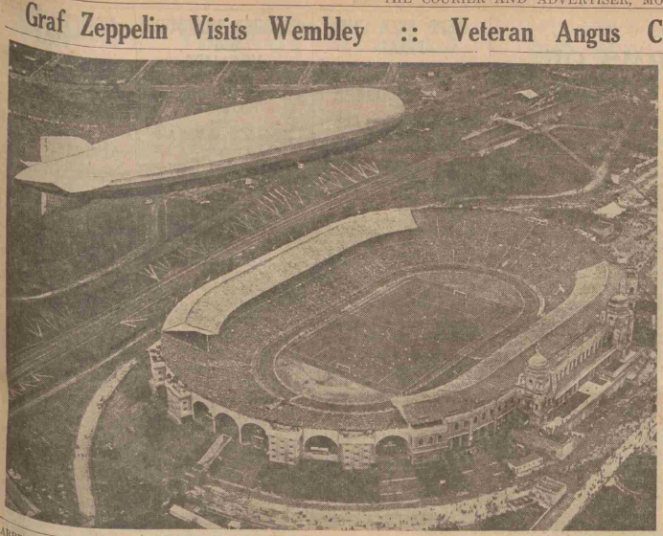
The Graf’s appearance over Wembley caused some controversy. It had been announced a few days before that the Zeppelin would be flying over London at the time the FA Cup final was taking place between Arsenal and Huddersfield Town, and Huddersfield manager Clem Stephenson was quoted in the press before as saying that “it will be a thousand pities if the airship is anywhere near while the game is in progress” but “by all means let it come before or immediately after the game.” (Lancashire Evening Post, 26th April 1930)
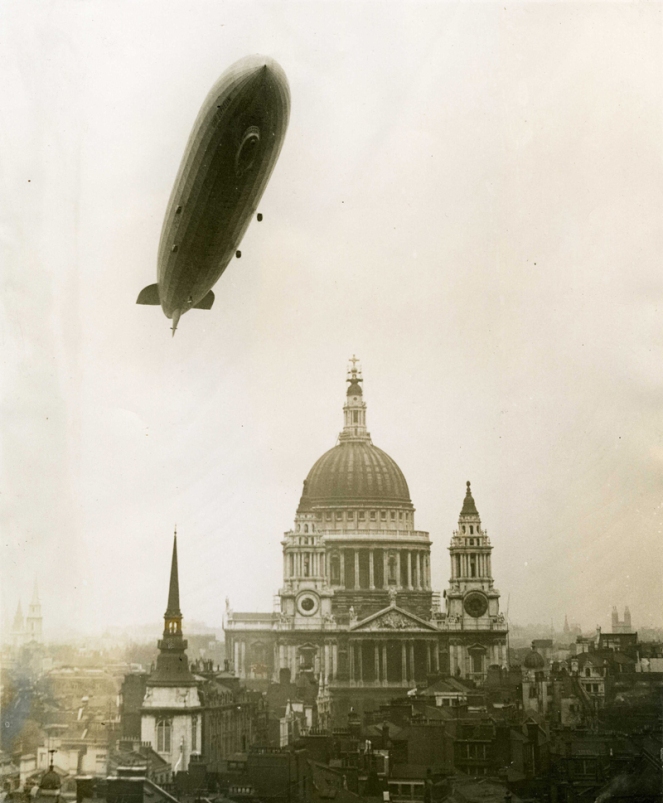
In peacetime, airships were the transport of choice for those wishing to travel long distances in style. The Graf Zeppelin began operating commercially in 1928, carrying large volumes of mail as well as passengers who paid handsomely for the privilege of travelling on such a luxurious airship. The Graf Zeppelin crossed the Atlantic Ocean regularly, and completed a round the world flight in 1929. The infamous Hindenburg disaster of 1937 forced the Graf Zeppelin into an early retirement, and the short-lived age of the airship came to an end.
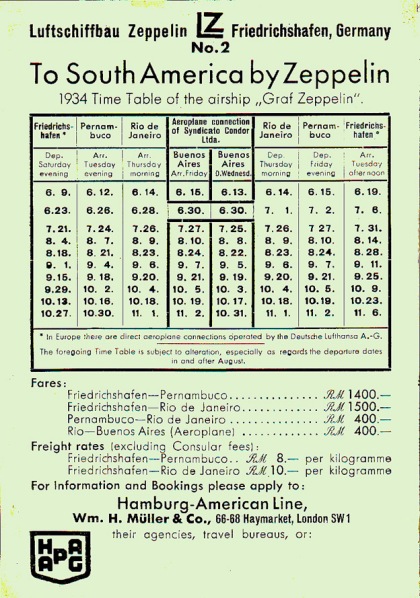
Since the demise of the airship in the late 1930s, London’s skies have become dominated by aeroplanes and helicopters. The airships that have occasionally taken to London’s skies have usually been advertising blimps, such as the Goodyear blimp – Goodyear originally manufactured airships in the 1920s, and today their fleet of modern blimps are a popular sight in cities around the world. When the Goodyear blimp was seen over London during the 2012 Olympics, it was viewed with smiles and interest by those on the ground – a far cry from those terrifying nights during the First World War when Londoners were traumatised by the Zeppelins and their bombs.
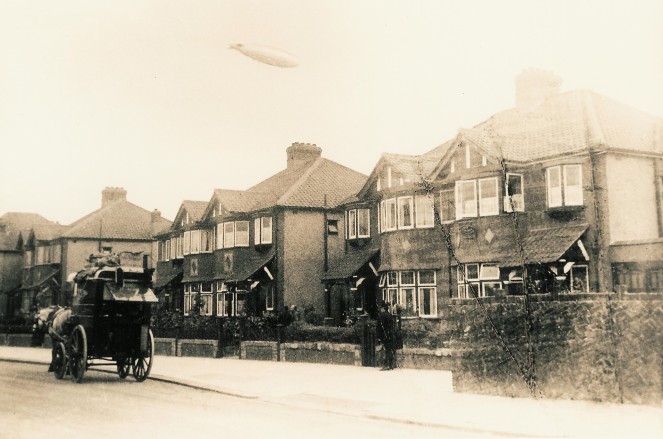
Update: 11.5.2015 – Thank you to Ian Castle, author of London 1914-17: The Zeppelin Menace, for correcting some erroneous information about the bomb damage in West Smithfield that appeared in the original version of this blog post, as well as researching the photograph of the R101 airship.
References and further reading
Jerry White – Zeppelin Nights: London in the First World War, Vintage Books, 2014
Neil Hanson – First Blitz: The secret German plan to raze London to the ground in 1918, Corgi, 2009
Zeppelin raids, Gothas and “Giants”, Britain’s First Blitz 1914-1918 http://www.iancastlezeppelin.co.uk/home/4582467808
Rare charts show WWI German air raids on Britain, Daily Telegraph, 7th November 2013 http://www.telegraph.co.uk/history/world-war-one/10430627/Rare-charts-show-WW1-German-air-raids-on-Britain.html
Zeppelin Airship Attacks on London: Mapped – Londonist, 29th July 2010 http://londonist.com/2010/07/wwi_airship_attacks_on_london_mappe.php
London Fire Journal – World War I, 23rd May 2013 http://londonfirejournal.blogspot.co.uk/2013/05/world-war-i.html
Airships.net – Graf Zeppelin History http://www.airships.net/lz127-graf-zeppelin/history


That was fascinating, just shows you what you find out about a few holes in wall, thank you for sharing 🙂
LikeLike
How terrifying the sight of an airship must have been, and that poster showing how to identify enemy airships and aircraft really brings it home. For me, I think that airships would possibly have been scarier than planes, because of their stealth and massive presence. A fascinating post, as always! 🙂
LikeLike
Thank you! The airships must have been so frightening, especially considering that the Zeppelin raids were the first time that air raids had been carried out over Britain.
LikeLike
Reblogged this on First Night History.
LikeLike
Once again, a fascinating journey into English history. I love your well researched and beautifully written “dispatches.” Bruce in Kansas City, Missouri.
LikeLike
Thank you Bruce!
LikeLike
Very iteresting my Godmothers school aas bombed by a zeplin she survived many didnt.amazing to think the first bombing raids were one hundred years ago, this. Month.
LikeLike
My godmothers school which was bombed was at the end of uppernorth street. There is a memorial there now
LikeLike
That bombing was such an awful tragedy. It must have been horrendous for your godmother to witness such a thing.
LikeLike
Somehow I missed this one. What a great post! If only there were (benign) airships over London again – as I’ve said more than once elsewhere, BRING ON THE SOLAR POWERED ZEPPELINS!
LikeLike